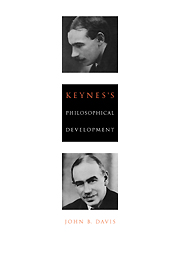Book contents
- Frontmatter
- Contents
- Preface
- Introduction: Keynes and philosophy
- 1 Keynes's early intuitionism
- 2 The dilemmas of Moore's Principia for ethics and economics
- 3 Keynes's self-critique
- 4 Keynes's later philosophy
- 5 The philosophical thinking of The General Theory
- 6 Ethics and policy
- Conclusion: Keynes's philosophical development
- Notes
- References
- Index
Conclusion: Keynes's philosophical development
Published online by Cambridge University Press: 28 August 2009
- Frontmatter
- Contents
- Preface
- Introduction: Keynes and philosophy
- 1 Keynes's early intuitionism
- 2 The dilemmas of Moore's Principia for ethics and economics
- 3 Keynes's self-critique
- 4 Keynes's later philosophy
- 5 The philosophical thinking of The General Theory
- 6 Ethics and policy
- Conclusion: Keynes's philosophical development
- Notes
- References
- Index
Summary
The issue of whether there is significant development in Keynes's philosophical thinking has been associated with the question of the continuity or discontinuity of that thinking (Bateman, 1991a; Skidelsky, 1992). But it must seem to many readers that though these alternative positions are clear in outline – that either Keynes's philosophical thinking in The General Theory remained essentially as it was in the Treatise, or that important elements of the earlier work were abandoned and new themes were introduced in the later work – ultimately whether one adopts the continuity or discontinuity view appears to be chiefly a matter of the emphasis one would like to put upon one's exposition of Keynes's philosophical views. Certainly proponents of both views admit elements of the opposite interpretation. Continuity theorists allow there are changes in Keynes's views, simply regarding them as comparatively minor modifications on major themes, and discontinuity theorists recognize continuities, allowing there to be a relatively constant backdrop against which Keynes made changes. Accordingly, since there seems to be really no way of establishing a definitive measure of the balance between change and permanence in Keynes's views, it seems that one interpreter's selection of themes for discussion sets one balance on the subject while another's selection simply sets another.
- Type
- Chapter
- Information
- Keynes's Philosophical Development , pp. 174 - 178Publisher: Cambridge University PressPrint publication year: 1994



